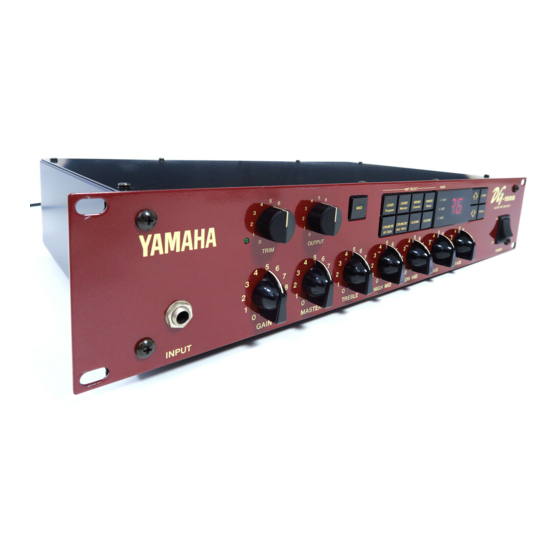Yamaha DG-1000 Manuale d'uso - Pagina 7
Sfoglia online o scarica il pdf Manuale d'uso per Amplificatore Yamaha DG-1000. Yamaha DG-1000 20. Guitar pre-amplifier

Store and Recall
The DG-1000 has an internal memory that can hold up to 128 amp type and settings. Each memory can be recalled at any time.
Motor drives in the knobs will automatically set them to the proper positions. Try storing a sound you created to memory.
Store Settings
1. Create a sound using the 8 preset amp types, GAIN, MASTER,
and the 5 Tone Controls. The EDIT lamp lights on the MODE
display.
* If MODE display's MIDI lamp is lit, press the
the EDIT lamp lights.
2. Use the
/
buttons to select the memory number to which
the settings will be saved. The memory number will flash in the
display.
* Press and hold one of the
bers cycle rapidly.
* The third digit of the memory number (100 – 128) is represented by
a dot between the two digits.
Sample) 128 is displayed as
3. Hold the
button, for about one second, until "
pears on the display.
Release the button, the flashing memory number will then light
indicating the setting is saved to memory.
* TRIM and OUTPUT settings are not stored in memory. Use the
MASTER knob to set backing and solo levels.
Lights
The memory number to be stored.
8. 8 .
Flashing
Lights
Data stored in memory (1 – 128) can be saved to an
external MIDI storage device. Refer to the next page
for details.
HINT
Some hints on storing memory numbers
When storing memory, divide the memory numbers 1 – 128 into
several groups.
Recalling memory from these groups is convenient. For example,
• Create groups according to the amp type (LEAD1, DRIVE 1, etc.).
For example, memory numbers 1 – 10 are LEAD 1 sounds.
• Create groups based on sound type (Distortion, Clean, etc.)
• Create groups based on live performance song lists.
• Create groups based on the type of guitar used (humbucker, etc.).
It's also a good idea to keep a chart listing what types of sounds
are stored in memory numbers.
button so that
/
buttons to make memory num-
8. 8 .
" ap-
Store Execute
Select the memory
number
Recall Memory (Recall)
The settings stored in memory can easily be recalled by selecting a
memory number.
1. Check the Mode Display lamp.
If PLAY is lit:
Go to the next step.
If EDIT is lit:
The current settings are not stored in memory. If you want to
save those settings, use the "Store Settings" procedure on
the left page, then proceed to the next step.
If MIDI is lit:
Press the
button to return to the PLAY or EDIT mode.
2. Use the
/
buttons to select the memory number to be
recalled. The memory number appears on the display (flash-
ing).
3. Press the
button. The flashing memory number will
then light. Each of the knobs, and the Amp Select Display will
change according to the data recalled from memory.
* Settings do not change until the
* TRIM and OUTPUT knob settings will not change with the Recall
operation.
* It takes anywhere from 1 – 10 seconds for the knob settings to change
however, internal settings (sound) will change instantly.
E1
* "
" will appear on the display if the volume knob does not go to
its assigned position, or the device does not recognize the recall com-
mand after 20 seconds from the start of the
Continued use of the device in this condition may result in fire or
electrical shock. Take the unit to the music dealer where you pur-
chased it, or to the nearest Yamaha Service Center for repair.
The memory number to be recalled goes from
flashing display
PLAY or
EDIT
Lights
Select the memory
number to be recalled.
A MIDI foot controller or other external MIDI device
can be used to select and recall memory. Refer to
the following page for details.
Initialize the memory
Use the following operation to restore all of the internal memory
(No. 1 – 128) to its original initialized condition (GAIN & MASTER
= 7, All tone controls = 5). Anything that you have saved to memory
will be lost so please use caution.
[Operation]
While holding both the
switch the POWER ON.
button is pushed.
operation.
lit display
Recall Execute
button and the
button,
5
